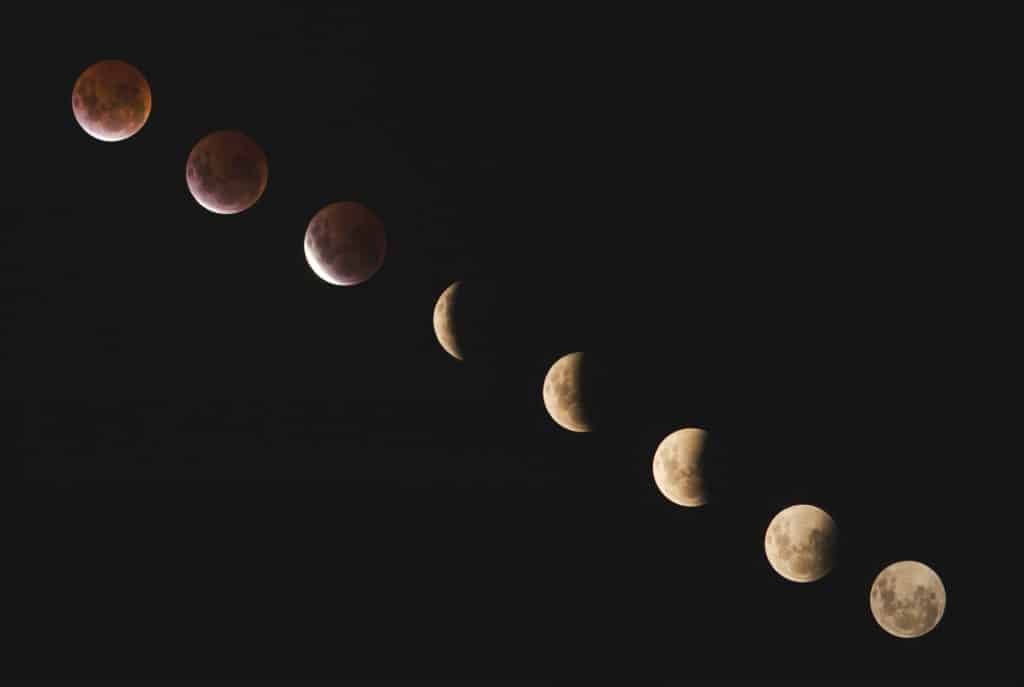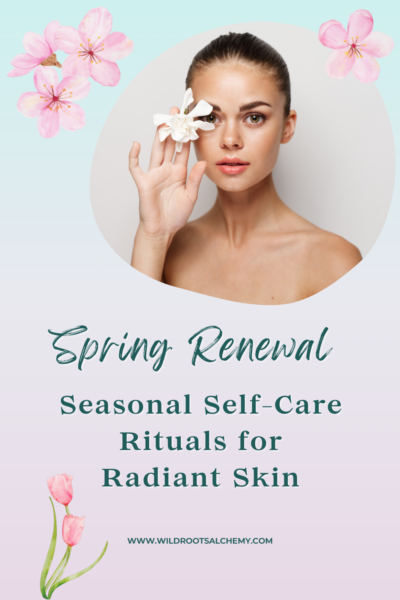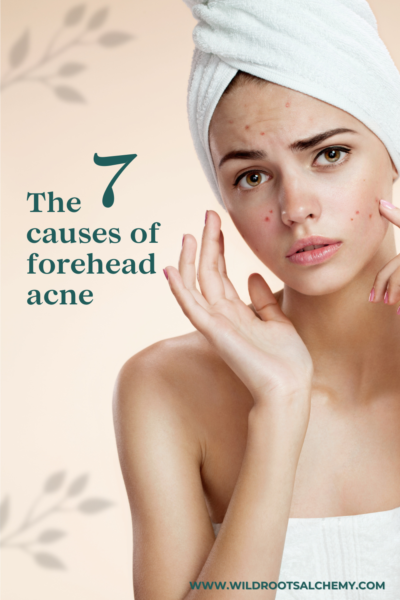
Our menstrual cycles are incredible. Every month, my menses reminds me of the absolutely amazing, awe-inspiring orchestration of hormones in my body—hormones that respond to our inner and outer environments and instinctively cycle along with the natural rhythms of the world around us.
As females, we are finely attuned to the rhythms of the natural world. While males are more aligned with the solar forces and the daily cycles of the sun (and their testosterone levels reflect this 24-hour correlation), women’s hormonal fluctuations are more nuanced as they are entwined with the lunar forces.
Our Monthly Moon Time
During our menstruating years, we cycle along with the waxing and waning phases of the moon. Just as the moon takes 29.5 days to complete her cycle, our menstrual cycles are typically similar in length.
The word “month” actually originated from the word “moon,” as a month is the time it takes for the moon to complete her cycle from new moon to the next new moon. In many places, menstruation is referred to as “moon time,” which is because “that time of the month” typically correlates to a specific moon phase!
A healthy menstrual cycle can align with any of the moon’s phases and can last anywhere from 26-35 days. However, it is historically common to start your menses on the day of the new moon and ovulate around the full moon.
A female’s menstrual cycle has two general phases: the follicular phase and the luteal phase. The follicular phase encompasses the two weeks from the start of menses to ovulation (days 1 to approximately 14) and the luteal phase is the second two weeks starting from the day of ovulation to the start of the next menstrual cycle (approximately days 15 to 28).
Just like a month can be split into roughly four weeks, a menstrual cycle can further be divided into four distinct phases. I’ll describe each phase below with its energetic and archetypal associations, physical and emotional experiences, hormonal changes, and a few key self-care recommendations.

Phase 1 (days 1-7): Menstruation (moon time)
Archetypal associations:
– Season: Winter
– Moon phase: New Moon
– Archetype: Wise Woman/Crone/Visionary
– Element: Earth
– Qualities: space, safety, comfort, letting go, sensitivity, rest
Phase (or week) 1 is all about menstruation, which typically lasts 3-7 days. During this time, you may feel tired due to your bleeding and the fact that your hormones are bottomed out. Despite the fatigue, you are an intuitive powerhouse during your moon time. You are in higher state of receptivity and sensitivity, and your energy is directed inward, promoting a focus on self-awareness and self-care.
Not only is your body physically releasing what it no longer needs via menstruation, you are also releasing toxic mental and emotional energy as well. Our monthly bleeds are a way for us to deeply reflect upon and let go of thought patterns and emotional burdens that aren’t in alignment with our true selves.
In alignment with the new moon, the start of your menses indicates a new cycle, a new beginning, and a time for inner reflection.
Just like the winter season, our moon time is a time to rest, reflect, and take care of ourselves in preparation for a strong surge of outward movement that is bound to arrive in the weeks to come. Self-care practices are essential during the first phase of our menstrual cycle—it’s a time to honor the wisdom of our bodies, and ultimately, of Nature.
Phase 1 Hormonal Changes
Estrogen and progesterone are at their lowest during your menses. In fact, the steep drop of these two hormones at the end of your last menstrual cycle is what triggers menstruation to start and the cycle to begin anew!
Since estrogen increases your serotonin levels, naturally low levels of estrogen at the onset of your menses may make you feel tired, moody, and wanting to be by yourself. (And that’s totally ok! It’s important to take time for yourself during your menses.)
Low estrogen and progesterone levels signal your pituitary gland to produce follicle stimulating hormone (FSH). FSH then tells one of your ovaries to begin ripening follicles in preparation for an egg to release.
The growing follicles start producing more estrogen. This means that soon after your period starts, estrogen levels slowly start to rise, which promotes the re-building of your uterine lining (endometrium) after it was sloughed off during menstruation.
Phase 1 Self-Care Recommendations
- Spend time alone out in nature
- Take naps and rest as much as possible
- Epsom salt baths
- Cozy up with a blanket, hot mug of tea, and a good book
- Restorative yoga
- Journal or free-flow writing
- Practice positive visualizations and intention-setting for the month to come

Phase 2 (days 7-13): Pre-ovulation
Archetypal associations:
– Season: Spring
– Moon phase: First Quarter Moon
– Archetype: Goddess/Maiden
– Element: Air
– Qualities: productivity, energy, focus, strength, renewal, fertility
Week 2 is all about prepping your body for ovulation. Your hormones are involved in an intricate dance, all designed to prepare an egg (or two!) for release as well as preparing you physically and emotionally to engage in behavior that will increase your egg’s chances of fertilization.
Just like the start of spring—when all life is reawakening from winter’s slumber—this week you may feel a renewed sense of well-being, a heightened mood, and more energy. Spring time is also for romancing—you may feel more sociable or want to be more intimate with your partner this week.
Even if fertilization and pregnancy are not in your plans, your biology is still crossing its fingers and giving you all the good stuff you’ll need in order to make it happen. This week is a great time to take advantage of all the positive effects your hormones are having in your life!
Phase 2 Hormonal Changes
Estrogen levels continue to rise until they peak. Your estrogen is highest right before you ovulate.
Rising estrogen levels lead to a number of noticeable changes right before ovulation:
- You become more optimistic and motivated.
- You feel more confident, sociable, and adventurous.
- You get a boost in mood, energy, and libido.
- Your memory is sharper.
- Tissues all over your body plump up, especially your lips, breasts, hips, and thighs. Your facial skin plumps too, smoothing out fine lines and wrinkles
- You may feel less hungry, as estrogen is a natural appetite suppressant.
Estrogen promotes proliferation of the endometrium (the lining of your uterus). High estrogen levels are also responsible for creating sperm-protective cervical mucus, which looks like egg whites during your most fertile days.
Testosterone levels also start to rise a few days before ovulation, elevating your libido even more.
Phase 2 Self-Care Recommendations
- Focus on projects, learning, and creating
- Physical activity (this is the time to do your high intensity workouts!)
- Eat light, healthy meals
- Engage in social activities
- Practice speaking your truth—your hormonally-assisted confidence will support you!
- Try new things and go to new places

Phase 3 (days 14-21): Ovulation (around day 14) and post-ovulation
Archetypal associations:
– Season: Summer
– Moon phase: Full Moon
– Archetype: Mother/Healer
– Element: Fire
– Qualities: deep sense of love and connection, nurturing relationships and community, expressive
Spring turns into summer in week 3 of your menstrual cycle. Energetically, summer is extroverted, dynamic, playful, and full of activity. It is the peak of the fiery yang energy of the year.
Analogous to summer, ovulation is a peak point in your cycle and is when your ovary finally releases a mature egg in hopes of fertilization. If the egg doesn’t get fertilized, your menses will begin about 14 days following ovulation.
Ovulation typically occurs on the full moon in cycles that begin on the new moon. The full moon has always marked the peak of illumination, extroversion, and energy—much like summertime. The full moon is correlated with heightened sexual desire—which makes sense if you are ovulating, evolutionarily-speaking!
If you’re looking to get pregnant (or even if you aren’t!), know that the highest chance of conception actually occurs about 1 to 2 days prior to ovulation since that is when you are the most fertile. (This is why tracking your menstrual cycle is so important!)
Following ovulation, you have a week of mellowing in your feel-good hormone progesterone. Summer is associated with the Fire element, and as a thermogenic (or heat-producing) hormone, progesterone quite literally warms you up like summer sunshine.
So this week, bask in the sunshine of progesterone!
Phase 3 Hormonal Changes
At the end of phase 2, rising estrogen levels trigger the release of luteinizing hormone (LH) from your pituitary gland, which stimulates ovulation.
About 24 to 36 hours after LH surges, ovulation occurs.
After the egg is released from the follicle, the remaining ovarian structure becomes the corpus luteum, which is responsible for secreting progesterone.
Progesterone has a number of positive (and sometimes not-so-positive) effects:
- Progesterone is thermogenic, increasing your basal body temperature throughout the second half of your cycle. (This is why measuring basal body temperature is a critical part of the Fertility Awareness Method and tracking your menstrual cycles!)
- Progesterone is a feel-good hormone! You want to be a part of your community, nurture others, and love up on your partner.
- Progesterone creates a sense of calm. Progesterone stimulates GABA receptors in your brain, which are responsible for calming down your nervous system and reducing anxiety.
- Progesterone stimulates your appetite. Your intelligent body wants you to eat for two in the event you got pregnant this cycle!
- Progesterone can cause constipation and bloating. The hormone slows down gut peristalsis in order to help your body absorb more nutrients from all that extra food you’re eating.
- Progesterone can lead to some fogginess or fatigue. While progesterone has calming effects, some women may be more sensitive to its sedating effects than others.
While progesterone is rising, estrogen has dropped but is slowly rising again for a second, smaller peak around the end of this week. Estrogen continues to stimulate proliferation of the uterine lining in preparation for possible implantation of a fertilized egg.
Testosterone has flattened out again but will rise just before ovulation of your next cycle.
Phase 3 Self-Care Recommendations
- Eat healthy, regular meals. Skipping meals can lead to low blood sugar and feeling “hangry” since you’re more sensitive to blood sugar drops during this week.
- Regular movement and sweating (mobilizes fat, stabilizes blood sugar, and reduces bloating)
- Date nights with your partner, or if single, ask someone out on a date!
- Family time
- Participate in community events
- Self-care abdominal massage to reduce constipation and bloating
- Go for a walk in the light of the full moon
- While I recommend sleeping in complete darkness for optimal sleep, keep your curtains open for three nights around the time of the full moon (the night prior, the night of the full moon, and the night following). This is to expose your body to the light of the full moon and help maintain a regular hormonal cycle. Our bodies and our hormones are significantly impacted by exposure to light. In a society rife with artificial light at all hours of the day, our bodies’ natural rhythms can get disturbed. Making sure to get your moonlight in can help! (I also recommend tracking the moon phases along with your cycle so you can mentally align with the lunar rhythms as well).

Phase 4 (days 22-29): Pre-menstruation
Archetypal associations:
– Season: Fall
– Moon phase: Last/Third Quarter Moon
– Archetype: Wild Woman/Priestess/Enchantress
– Element: Water
– Qualities: going inward, increasing stillness, slowing down, transformation
Fall season is all about winding down from the extroverted, yang energy of summer. As our estrogen and progesterone levels start to drop this week, we may notice the desire to be more introverted, take on fewer tasks, and find more stillness in our everyday lives. This is all in preparation for our menses, which births us back into a new cycle yet again.
With the Water element, this week shines a spotlight on our emotions, which can shift significantly from moment to moment, especially if our hormones aren’t optimally balanced.
Regardless of our hormonal health, it is natural to experience some mood swings or low energy at this time. This is a signal that we need rest and space for our own self-nourishment. Our bodies want to be cared for during the week leading up to our period, yet what our bodies crave can clash with what society (or our friends or family) “expects” of us.
It can be challenging to set boundaries with all of the demands that are placed upon us as women, but severe PMS symptoms may be your body signaling loud and clear that she wants to be listened to and treated with love and kindness.
Phase 4 Hormonal Changes
During week 4, both estrogen and progesterone start to dramatically decline if a pregnancy didn’t occur. The significant drop of our feel-good hormones often creates a sense of wanting to withdraw from social activities and stay at home. We may also experience some irritability, sadness, or anxiety with in a low estrogen and progesterone state.
Low estrogen levels also mean you may have a bigger appetite and crave more carbohydrate-heavy foods. Carbs promote serotonin production, making up for the lack of estrogen-associated serotonin.
Phase 4 Self-Care Recommendations
- Practice setting boundaries with your friends and family. Turn down social events if you need to. Stay home if you want. This week you may not feel like socializing, so listen to what your body wants and try to make yourself the priority.
- Spend time alone out in nature
- Get a massage, a facial, or a really long foot rub
- Eat healthy, nourishing foods. If you’re craving carbs, opt for nutrient-rich, high-fiber carbohydrates like squash, root vegetables (sweet potatoes, yams, beets, parsnips), beans, quinoa, and brown rice.
- Gentle movement, like yoga
Photo in featured image courtesty of luizclas from Pexels.





